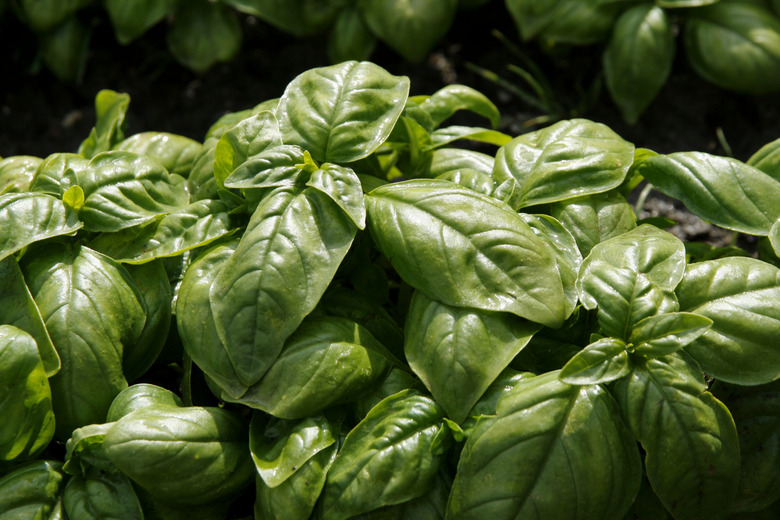What Causes Droopy Leaves In Basil?
Whether grown as a garden annual or kitchen-windowsill herb, basil (Ocimum basilicum) generally has few problems. Occasional root troubles may change its leaves from green and glossy to dull and droopy. Few remedies exist for root-damaged basil plants.
Whether grown as a garden annual or kitchen-windowsill herb, basil-plant-turning-brown.html'>basil (Ocimum basilicum) generally has few problems. Occasional root troubles may change its leaves from green and glossy to dull and droopy. Few remedies exist for root-damaged basil plants. For a steady supply of healthy leaves, the best option is to plant a disease-resistant basil cultivar and water it appropriately.
Fusarium Fungus
By the time a basil's leaves droop from Fusarium wilt, the plant is already past saving. Recently infected basil continues growing normally, until it reaches 6 inches to 1 foot tall, when its growth stops and the leaves become yellow and droopy. In the final stages of Fusarium infection, the stems twist and brown and the leaves drop. The fungus responsible for the trouble survives in the soil for years, ready to strike whenever basil is planted. It also spreads through contaminated seeds, so indoor basil should only be grown from seed labeled Fusarium-free.
- Whether grown as a garden annual or kitchen-windowsill herb, basil (Ocimum basilicum) generally has few problems.
- Recently infected basil continues growing normally, until it reaches 6 inches to 1 foot tall, when its growth stops and the leaves become yellow and droopy.
Root Rot and Damping Off Disease
Root rot fungi (Pythium spp., Rhizoctonia spp.) make inroads on basil's root system, its leaves wilt, yellow and die back from the branch tips inward. Dig up the ailing plant; peeling roots mean Pythium and brown, sunken spots mean Rhizoctonia. Damping off disease strikes newly emerged seedlings, girdling their stems with rot so they wilt and collapse near the soil line.
Fighting Root Diseases
The best option for controlling Fusarium, root rots and damping off is to dig up and discard affected plants along with the surrounding soil, advises the Missouri Botanical Garden. Wait at least four years before replanting it where Fusarium has been a problem. When you do replant, go with the resistant "Nufar" cultivar (Ocimum basilicum "Nufar"). All these diseases flourish in wet soil. To discourage them, improve your soil's drainage by working a 2- to 3-inch layer of organic, plant-based compost into its top 6 to 8 inches before planting. When growing basil indoors, use fresh, sterilized soil-free seed-starter and pots with drainage holes.
- Root rot fungi (Pythium spp., The best option for controlling Fusarium, root rots and damping off is to dig up and discard affected plants along with the surrounding soil, advises the Missouri Botanical Garden.
Root Knot Nematodes
Root knot nematode larvae (Meloidogyne spp.) inject a bump-raising chemical in basil's roots, where they feed, mature and lay eggs. Basil drooping in the heat of the day and failing to perk up by nightfall, even after watering, probably suffers from a nematode infestation. Short, bushy roots covered with pale-brown bumps confirm the diagnosis.
Nematode Nemesis
Root knot nematodes infest many plants, so rotating basil with other crops won't eliminate them. A better option is to solarize the basil bed during midsummer. Till and water the top 1 foot of soil before covering it with clear, 1 to 2.5 mil plastic sheeting. Secure the edges of the sheeting flush against the ground with mounded soil. Leave it for four to six weeks if your summers are hot, or six to eight weeks if they are cooler or cloudy. Pot indoor basil in nematode-free, sterile medium.
- Root knot nematode larvae (Meloidogyne spp.)
- Root knot nematodes infest many plants, so rotating basil with other crops won't eliminate them.
Watch the Watering
Even the healthiest basil droops from too little water or when excessively wet soil suffocates its roots. University of Minnesota Extension recommends watering outdoor plants weekly until the top 8 inches of soil are wet. If they're in containers, check the basil daily and water as needed to wet the top 8 inches of medium. Water indoor basil when the top 1/2 inch of medium is dry to the touch.
References
- University of California Sonoma County Master Gardeners: Basil
- Cornell University Department of Plant Pathology and Plant Microbe-Biology: Basil Diseases
- Colorado State University Denver County Extension Master Gardener: 2001: Year of the Basil
- Clemson Cooperative Extension: Basil
- University of Illinois Extension: Report on Plant Disease: Damping Off and Root Rots of Houseplants and Garden Flowers
- Missouri Botanical Garden: Fusarium Wilts and Rots
- UC Statewide IPM Online: Nematodes
- Kansas State University Extension: Plant Pathology: Root Knot Nematode of Tomato
- UC Statewide IPM Online: Soil Solarization for Gardens & Landscapes
